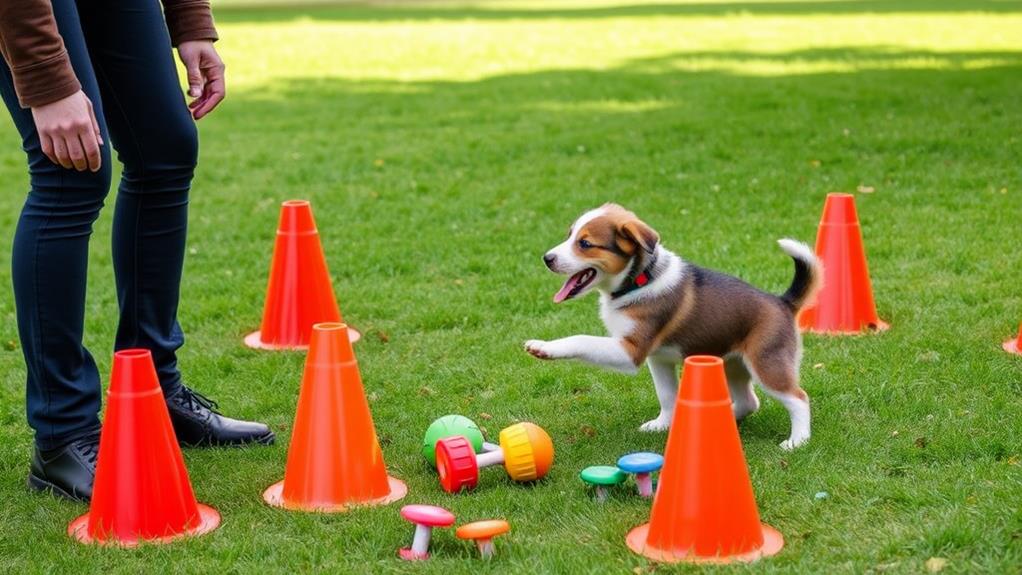To train your dog effectively, start by choosing the right toys that fit their size and interests. Use these toys to grab their attention when teaching commands like "sit" or "stay." Incorporating toys as rewards for good behavior reinforces learning and keeps your dog motivated. Balance structured training sessions with playtime to strengthen your bond. Monitor your dog's engagement by observing their body language and rotating toys to keep things fresh. By adjusting your training methods based on their responses, you'll create a fun learning experience. There's plenty more to explore on how to make training exciting!
Choose the Right Toys

Choosing the right toys is essential for effective dog training. The toys you select can greatly influence your dog's engagement and learning.
Start by considering your dog's size and breed. A small toy mightn't hold up against a large, strong dog, while a hefty toy can be overwhelming for a tiny pup.
Next, think about your dog's interests. Some dogs love to chew, while others prefer to chase or retrieve. Opt for toys that cater to these preferences to keep your pup motivated during training sessions. For example, if your dog enjoys chewing, durable chew toys can be excellent for redirecting unwanted behaviors.
Additionally, look for toys that stimulate your dog's mind. Puzzle toys can challenge them and encourage problem-solving, which is beneficial for their overall learning process.
Safety is also paramount; avoid toys with small parts that can be swallowed or toys made from harmful materials. Investing time in selecting the right toys can lead to more effective training and a happier dog. You'll find that the right toys not only enhance training but also strengthen the bond between you and your furry friend.
Incorporate Toys in Commands

Incorporating toys into your dog's command training can make learning more enjoyable and effective. Using toys as part of your training routine helps capture your dog's attention and keeps them engaged. Start by selecting a toy that your dog loves, whether it's a squeaky toy, a ball, or a tug rope.
When teaching commands like "sit," "stay," or "come," hold the toy in front of your dog to grab their focus. For example, while teaching "sit," raise the toy above their head. As they look up, their bottom will naturally lower to the ground. Once they sit, reward them with the toy as a fun incentive.
You can also incorporate toys into more advanced commands, like "drop it" or "fetch." When your dog brings back the toy, encourage them to drop it by saying the command while showing another toy. This keeps the session lively and encourages your dog to respond quickly.
Use Toys for Positive Reinforcement

Toys can be powerful tools for positive reinforcement during your dog training sessions. When your dog successfully follows a command or exhibits desirable behavior, reward them immediately with their favorite toy. This creates a clear association between the action and the reward, making it more likely they'll repeat that behavior in the future.
Choose toys that engage your dog's interest, whether it's a squeaky toy, a plush companion, or a tug rope. The excitement of play can elevate your dog's motivation to learn. Timing is vital; be sure to present the toy right after your dog performs the desired behavior. This helps them connect the dots.
You can also use toys in various ways to keep the training engaging. For example, during fetch, ask your dog to sit or stay before throwing the toy. Once they comply, let them retrieve it. This reinforces command obedience while making training fun.
Balance Playtime and Training

It's easy to get caught up in the excitement of using toys for positive reinforcement, but balancing playtime and training is key to effective learning. While toys can motivate your dog, too much play can dilute the training's effectiveness. You want your dog to associate toys with learning, not just fun.
Start by setting clear training sessions that incorporate toys as rewards. For example, use a favorite toy to praise your dog when they obey a command, but keep these moments brief and focused. This way, your dog learns that toys are earned through good behavior, strengthening the link between play and training.
After a training session, allow some unstructured playtime. This helps your dog unwind and reinforces the idea that play is a reward for listening. Remember, variety is essential. Rotate toys to maintain your dog's interest and prevent boredom, ensuring they stay engaged during both training and play.
Ultimately, aim for a healthy mix of structured training and relaxed play. This balance not only enhances learning but also nurtures a strong bond between you and your dog, making training sessions more enjoyable for both of you.
Monitor Your Dog's Engagement

Monitoring your dog's engagement during training sessions is crucial for effective learning. If your pup seems distracted or uninterested, it's a sign you might need to adjust your approach. Keep an eye on their body language; a wagging tail and bright eyes indicate excitement, while yawning or turning away can signal boredom.
One way to maintain engagement is by using toy aids that capture your dog's attention. Rotate different toys to prevent monotony and keep your sessions fresh. Incorporate these toys into your training routine by using them as rewards or tools to demonstrate commands. For instance, you can use a favorite toy to encourage your dog to fetch, reinforcing the action with positive feedback.
Also, be aware of the length of your training sessions. Short, focused bursts of training often yield better results than longer, drawn-out sessions. It's important to take breaks and allow your dog to play with their toys, ensuring they stay motivated and keen to learn.
Ultimately, keeping track of your dog's engagement will help you tailor your training methods, making the experience enjoyable for both of you while fostering a strong bond.
Frequently Asked Questions
What Types of Toys Are Safest for Aggressive Chewers?
When choosing toys for aggressive chewers, opt for durable materials like rubber or nylon. Look for specifically designed chew toys, and avoid anything with small parts that could break off and pose a choking hazard.
How Often Should I Replace My Dog's Toys?
Think of your dog's toys as a garden—some flourish while others wither. You should replace them every couple of months, or sooner if they show wear. Fresh toys keep playtime exciting and safe for your furry friend!
Can Toys Be a Distraction During Training?
Yes, toys can definitely be a distraction during training. They might divert your dog's focus away from commands. It's important to manage their use, ensuring your pup stays engaged with you for effective learning sessions.
Are There Any Toys That Help With Anxiety?
When anxiety grips your pup like a storm, interactive toys like puzzle feeders or calming plushies can be your lifeline. They engage your dog's mind, providing comfort and distraction during those turbulent moments.
Can Toys Be Used for Socialization With Other Dogs?
Absolutely, toys can facilitate socialization with other dogs. By encouraging play, you create a fun environment where dogs interact, build confidence, and learn social cues, making it easier for them to connect with each other.
Conclusion
By incorporating these tips, you'll not only enhance your dog's training but also strengthen your bond. Isn't it amazing how a simple toy can turn a mundane command into a fun game? As you balance playtime with training, you'll notice your dog's enthusiasm growing. Remember, every tug on that rope or bounce of that ball is a step toward a well-trained pup. So grab those toys, and let the adventure begin—together!



